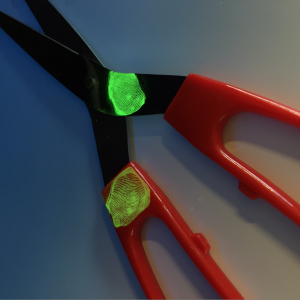This strong luminescent effect creates a greater contrast between the latent print and surface, which in turn creates higher resolution images making analysis easier and more precise.
The technique’s founder, Dr. Kang Liang, from the Commonwealth Scientific and Industrial Research Organization, believes that this new method could be used for more challenging evidence where conventional ‘dusting’ is not appropriate.
“While police and forensics experts use a range of different techniques, sometimes in complex cases evidence needs to be sent off to a lab where heat and vacuum treatment is applied,” said Dr. Liang.
“Our method reduces these steps, and because it’s done on the spot, a digital device could be used at the scene to capture images of the glowing prints to run through the database in real time.”
How it works
Fingerprints glowing on metal and plastic.(Image via CSIRO)
The study shows that tiny crystals rapidly bind to fingerprint residue, including proteins, peptides, fatty acids and salts, creating an ultrathin coating that’s an exact replica of the pattern.
“Because it works at a molecular level it’s very precise and lowers the risk of damaging the print,” said Dr. Liang.
CSIRO tested the method on nonporous surfaces like windows, wine glasses, metal blades, and plastic light switches, proving success.
For over 100 years, law enforcement groups have turned to fingerprinting to help fight crime. Dr. Liang and the orginazation believe that the new method could save time, costs, and help improve investigations.
“Knowing that dusting has been around for a long time, I was inspired to see how new innovative materials could be applied to create even better results,” said Dr. Liang. “As far as we know, it’s the first time that these extremely porous metal organic framework (MOF) crystals have been researched for forensics.”
Benefits of using MOF crystals include less expense, quicker reactions, and bright light emissions. The technique also doesn’t create any dust or fumes.
Not only are the researchers looking to partner with law enforcement agencies to see the technique in action, but they also see potential applications in biomedical devices and drug delivery.
The research was published in theAdvanced Materials journal today.



